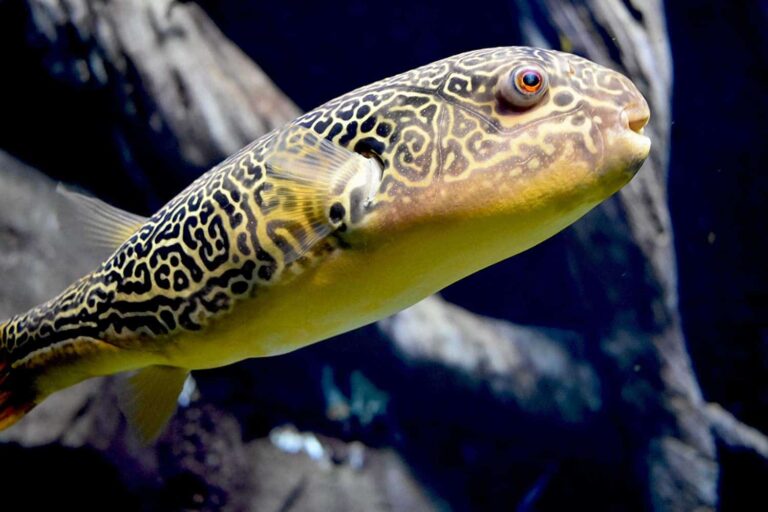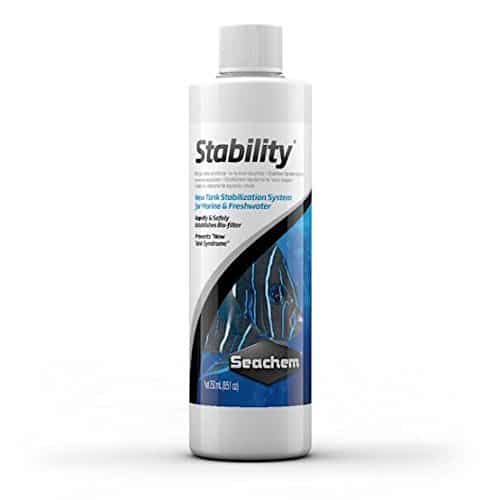The inhabitants of your aquarium need heat to survive the freezing atmosphere of winter! That’s why we place a premium quality aquarium heater to provide these pets the utmost comfort.
But beware; In some cases, even the most expensive models often malfunction despite having the correct setting and your little friend may suffer the consequence. To avoid such a heartbreaking scenario, spending a few extra bucks on the best aquarium heater controller can be a fantastic solution.
Luckily there are specific products out on the market now designed specifically for this purpose, and here, I will review the top 6 among them. So, keep scrolling…
What is an Aquarium Heater Controller?
An Aquarium heater controller is an electrical device that takes over your heating [and cooling] systems installed in your aquarium. It will control the temperature inside your aquarium in accordance with your settings.
Most heater controllers come with alarms or emergency shutdown protocols, preventing accidental overheating scenarios, making it an exceptionally beneficial product.
6 Best Aquarium Heater Controller reviews
An Aquarium heater controller is positioned out of the tank and it activates the heater. There are plenty of choices offering diverse features and you could easily get confused while picking one. So, I have handpicked some of the finest aquarium heater controllers and reviewed them below to assist you to make a worthy decision.
1. Hygger Titanium Aquarium Heater with Controller
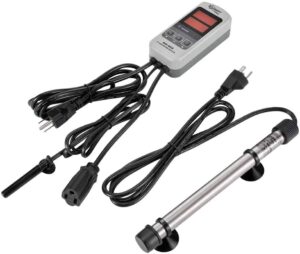
If you’re expecting to get a reliable heater controller that comes with an aquarium heater – then you need something like this Hygger sensational aquarium heater plus controller.
This is an excellent option for beginners who just finished the construction of his/her adorable aquarium and looking for a high-quality submersible water heater equipped with a heater controller. Yes, it offers everything that is required in a highly efficient and reliable device.
This becomes better with the precise and simply maneuverable controller that is fully automated too. That means, all you need to do is to set the highest as well as lowest temperature limit and the controller will take care of the rest.
The controller screen also visualizes both current water temperature and set temperature data either Celsius or Fahrenheit according to your preference. And, a red light flashing on the controller indicates the heater is on.
Plus, the thermostat controller’s interface is super easy which lets you set up everything in a breeze. The kit is ideal for tanks that hold 20-45 gallons of water and comes with long cords to place it conveniently. Moreover, the holes behind the controller also simplify the mounting equations.
The compact heater or heating rod is made of a heavy-duty titanium rod to ensure optimal performance in both salt and freshwater. Don’t worry; this bar is corrosion resistant and heats water in no time.
- Easy to operate and set up
- It offers long-lasting performance
- Affordable price tag
- The display is difficult to read from a distance
2. Inkbird ITC308S Temperature Controller for Aquarium
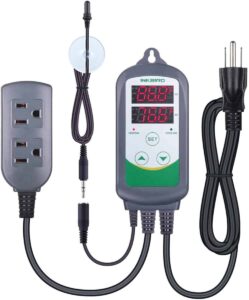
A digital aquarium heater controller is an excellent option for preventing your tank from overheating, and this device from Inkbird is a master of this art.
The best thing about this controller is that it senses 3 types of situations and will alert you when necessary. They are high temperature, low temperature, and faulty sensor alerts. That’s why this digital controller is so essential – keeping all that aggravation at bay by alerting us when there might be something wrong before anything actually happens.
Moreover, it features an innovative dual relay output system which gives you the privilege to control both the heating and cooling system. You guessed it right; the controller comes with two outlets to connect with both types of systems. The most interesting thing is you can use both ports at the same time to control two of your aquariums’ heaters.
Even more impressive is the fully submersible aquarium-safe probe that ensures precise temperature measurements and performs better than other standard probes. Plus, this durable machine can handle a maximum load of up to 1200W and will operate at 110v.
You will also love its double digital display windows which show set and measured temperature. Moreover, you can see this information in Fahrenheit as well as the Centigrade unit. You don’t require any special skills to set up the device and it will provide a satisfying service too.
- Very simple design and setup
- Dual relay output
- Precise temperature measurement and control
- A poorly written instruction manual may mislead you.
3. Inkbird C929A Smart Digital WiFi Heater Controller

Here is another Inkbird heater controller for you and It’s a smart device incorporating modern and groundbreaking technology to make your aquarium’s temperature maintenance task effortless. You can easily guess from its name that this magnificent guy uses WiFi technology to monitor your aquarium’s temperature.
Its data can be seen on your smartphone using the free app called “InkbirdSmart”. The great news is that this app has the simplest interface and is compatible with both Android & IOS 13 and above. So, you can always stay updated about the condition of your tank’s water while you are not around.
Well, it also shows necessary measurements on the LED screen in case you are facing any issue regarding the connectivity of your handset. The wireless system controller is equipped with two waterproof probes to give you accurate readings and 2 layers of protection. You will hear an alert when the device senses any fault or temperature fluctuations.
And you can make it work with almost any type of heater as it runs on 110v and withstand a max load of 1200w. It also has a built-in dual relay to prevent overheating. You will also get temperature data in both Fahrenheit and Centigrade format. So, choose the format you prefer.
- You can control your aquarium heater remotely
- It comes with 2 waterproof probes
- Compatible with both Android and iPhone
- You may face issues with the stability of the app
4. Finnex HC-0810M Digital Temperature Controller
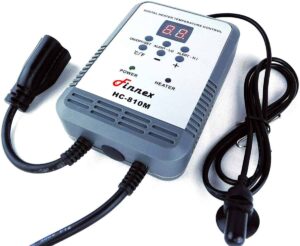
Finnex HC-810M is a splendid choice for a fully automated temperature controller. It is extremely easy to control water temperatures with it, courtesy of the precision digital control, which comes with a simple LED display.
Having one of these would surely be great for your aquarium fish as it’ll eliminate the risk of temperature fluctuations. We all know how delicate fish are, a little change in temperature severely changes their behavior and activities.
With this model’s advanced digital heating feature, you have superior control over your aquarium, easily switching your temperature low or high as you wish. It’ll remember your settings so even if the power goes out, there is the memory that stores that data.
You can even have a select few preset settings saved up, letting you switch between settings pretty easily.
This machine would let you know in case of erratic temperatures by setting off an alarm.
You can’t be in front of your aquarium 24/7, so what if there is overheating? Not to worry, it’ll also automatically shut down in case excessive heat is being omitted, this is a feature I find very handy.
The default high and low-temperature alerts are set at 93 and 67 degrees Fahrenheit, respectively, but you can change it to your preference. The accuracy of this device is +/- 2F.
- It has an easy to read LED display
- 800W load-bearing capacity
- Automatic overheating protection
- Steady temperature control
- It doesn’t show decimals
5. Inkbird ITC306T Aquarium Heater Controller
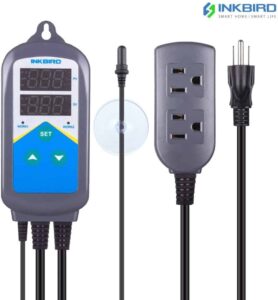
In the market of top-notch controllers, few options are as dependable as the Inkbird ITC306T model. Because of its super-efficient and extremely easy interface, we can say it is the best Aquarium heater controller with a fully submersible probe.
The heat-controlling technology it offers is outstanding in terms of consistency and results. It works far better than any heater’s internal thermostat and you will surely enjoy the convenience.
Talking about convenience, this unit has a unique dual time cycle setting that will help you to set and monitor 2 different temperatures for 24 hours. Yes, this thing keeps you relaxed by controlling two different temperatures at day and night.
And what’s even better, it works with almost all types of aquariums and shows temperature data on its LED screen precisely. Just calibrate it to a trusted thermometer and it is ready to do its duty.
Moreover, like other Inkbird models, this one also displays current temperature and set temperature as Fahrenheit or Centigrade.
As it can monitor and handle two Aquariums’ heating systems simultaneously, the device comes with two lights leveled as “Work1” and “Work2” to indicate whether the heaters are running or not. Also, its built-in ultra-capacitor lets the timer chip keep running for 20+ days without electricity.
- It has day and night control mode settings
- Its double socket system will allow you to control 2 Aquariums’ temperature
- It comes with a faulty sensor alarm and an over-temperature alarm system
- Settings are a bit complicated
6. Bayite Aquarium Temperature Controller
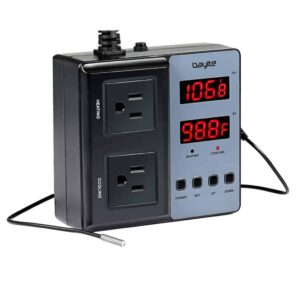
Sometimes, aquarium owners just want something simple. In this case, such people would just want a temperature controller that accomplishes its job, and none of that fancy stuff. They’re also likely to have a tight budget.
For them, Bayite is a match made in heaven. It’s an incredibly simple device from the outside. But it has a lot of interesting features. All of them together make it an exciting low-budget heater controller.
Its design is pretty simple, easy to set up and understand. Just plug it and play. One of its most useful features is that not only it works with a heater, but also with a cooler too! Wait up, I haven’t even come to the best part. You can use it with a heater and a cooler simultaneously!
That’s right. With the dual relay output, it becomes a 2-in-1 controller!
Whenever the temperature of the aquarium becomes too high or too low, an alarm would ring, letting you know to act on it fast. You can set a safe temperature too.
There is one problem however, you have to unplug the power source when not in use. Because otherwise, it’ll automatically turn on whenever power is restored. This was meant to be a useful feature but if you don’t pay attention, it can cause you heavy damage.
- Simple and straightforward interface
- Can be used with heaters and coolers simultaneously
- Dual display showing real-time and preferred temperature
- 1100W output capacity
- Temp probe is not as accurate as other high priced competitors
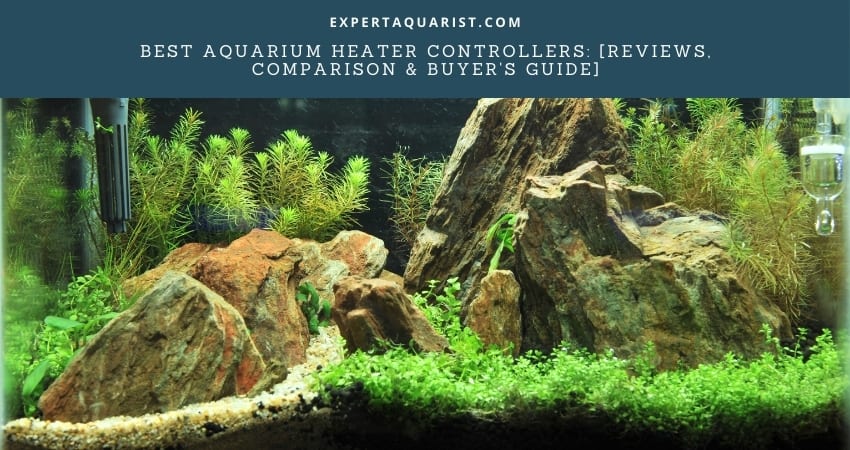
How to Choose a Heater Controller For Your Aquarium: Buying guide
To a simple owner who hasn’t explored the vast world of aquariums and its necessary equipment yet won’t be able to differentiate between aquarium heater controllers. I don’t blame them, the differences are so minor that a lot of people are bound to get confused.
But, I’m here to save the day. I’ll tell you some key factors that you should look at when you’re going shopping for the best aquarium heater controller.
Here are the things you should look at:
Capacity
This is an obvious one, your heater controller is an electrical device. And, electrical devices can only do as much as they’re capable of. The indicator of their capacity is Wattage [W].
Suppose, your controller has a capacity of 1000W. It means, it can control a heater of 1000W or below 1000W, or 2 different heaters of 500W, or any combination that adds up to 1000W in total.
But, it can’t go above 1000W. So, the first thing you do is check the manufacturer’s information and see how much load it can bear, and cross-check with your heater.
I’d suggest getting a controller that has a little bit more capacity than what your heater demands, for a smooth long-term run.
Saltwater or freshwater aquarium?
This is also another important thing to look out for. In freshwater aquariums, you just need a waterproof probe. But, that’s not the same for saltwater aquariums, as they can easily corrode metals.
Luckily for you, modern probes are replaceable. If you happen to have a saltwater aquarium, it’d be best to get a titanium probe. A DIY solution would be to cover the entire probe with a heat sink.
Cooling devices
You must have your priorities straight. Are you just gonna have a heater installed? Or will it have both a heater and a cooler? If you plan to have both you’d need a dual-stage heater controller.
Usually, people who live in a cold climate throughout the year opt for a basic heater controller. And those who happen to encounter fluctuating temperatures happen to prefer having both a heater and cooler to have a steady temperature in their tanks.
Does it have its own heater?
If you don’t have a heater already, you can think about getting a product that comes with a heater included. That’d be like a 2-in-1 deal. The benefit to getting a product like this would be that the controller would be already perfectly compatible with the heater, without you having to adjust it.
Alarm high/low temperature
I believe you must pick a heater controller that can notify you of high and low temperatures. This way you’ll have total control over how much temperature you want in your tank.
I’ve heard a lot of woes where people went for low-quality heater controllers that malfunctioned and ended up ruining their aquarium. But with an alarm, you’ll immediately know about what’s going on in your tank and act on it.
If the product you choose meets most of these criteria, then you’re on the right track.
How to set up an Aquarium Heater Controller?
It’s not a hard task at all. I’ll show you a DIY procedure:
Necessary equipment
- Heater controller
- Acrylic sheets
- Drill
- Saw
- Receptacles
- Marker
- Glue
- Extension cord
DIY method of setting up aquarium heater controller
Now, let’s start!
- Place acrylic on a flat surface, you’ll make a box out of them to fit the controller in there. Plastic frames also work as a box, but I believe acrylics are more durable. You’ll need at least 6 pieces.
- Place the heater controller in a standing position, then lay down the receptacles. Trace around them using a marker.
- Drill holes for wires to go in and out, and use the saw to cut an area so that the receptacles can sit and the controller can stand.
- Just for the time being, think of the acrylic sheet you’ve worked on as the “bottom” of the box, that’ll make directions easier. Now, take 4 more acrylic pieces, glue them up and attach them on all 4 sides, making the “walls”. You’ll be keeping the “top” open for now to insert the controller.
- Place the controller in, then the receptacles in their designated slots. The wires will go through the holes. Alternatively, you can have one big hole for all the wires to go in. I like the first idea better.
- Pay attention to this part, you gotta get it right. Cut the extension cord, you’ll use the cut part on the controller to connect with the receptacle, while the remaining cable of the cord will also connect with the receptacle.
- Not all controllers are the same so it’s hard to give a generalized wiring guide here. Follow the instruction manual to see how to set up the wiring.
- After you’ve set it all up, Slide in the “top” piece.
- Turn on the controller. Set Celcius or Fahrenheit if it supports both. If you’re in the US, Fahrenheit would be better for you. Next, set up the temperature you want.
- Then you set up the differential temperature. Set it 1-2 degrees so that there’s less fluctuation.
- Repeat the process again for the cooling system if it’s a dual-stage controller.
- Calibrate the controller according to the instruction manual.
- Put the probe inside the aquarium.
That’s it, your aquarium heater controller is all set.
How Does An Aquarium Heater Controller Work?
The simplest way I can describe an aquarium heater controller is that it’s a device to control how much heat passes through your aquarium. Think of it as a command center.
Now, before we get into the in-depth discussion, I must give you a little more detail of its roles- A standard aquarium heater can be 2 types:
- Single-stage
- Dual stage
A single-stage controller is the most basic heater controller. It has only one job and it does that perfectly- it’ll heat up the tank until it reaches a set temperature and when that’s achieved, the heater will shut down. Most aquarium owners are satisfied with this.
In comparison, a dual-stage controller is a straight upgrade; for an added cost, of course. It’s for those aquarium owners who want to take every bit of precaution into account and mainly wanna remove the risks of overheating by water chiller whenever the aquarium gets too hot.
But it doesn’t stop at overheating only, you can also set up a minimum parameter. Whenever the temperature falls below the set number, it’ll turn the heat up, keeping the tank at your desired heating condition.
Since we got that out of the way, let’s discuss how does a heater controller work. A heater controller has 3 main components- the main controller unit, socket, and sensor.
It’d be easier if I explain the entire operation by explaining every component:
Controller unit
They’re the mastermind of the entire machine. It’s responsible for reading the temperature and keeping it inside the set parameters. They’ve got LCD/LED displays, button commands, alarms, etc.
Socket
This is where you plug in a heater or a chiller. It’ll have only one outlet if it’s a single-stage [for heater only], and two for dual-stage [both heater and cooler].
Sensor
They’re also called temperature probes. It is usually submerged in the tank water and collects information about the temperature of the environment inside the aquarium. This is both the most important and most vulnerable part of the device.
Now that you know what each component does, put them together and you get the entire process of how an aquarium heater controller works:
- You set the preferred temperature.
- Through the sensors, the control unit monitors the entire situation
- The socket will adjust the temperature in accordance with your preferred temperature.
So that’s it, I know I took a pretty roundabout way to explain, but hey! Now you know this machine inside out!
What are the benefits Of an Aquarium Heater Controller?
An aquarium heater is a crucial thing that can’t be missed for any serious fish keeper. It enables the correct water temperature to be maintained. But, you need a separate heater controller device to prevent any unwanted situation which may occur due to the failure of the heating system. So, a heater controller is essential too. Let’s see some of its benefits
Cost-effective solution:
The Aquarium heating system is very delicate and it costs real money to fix it when it breaks. So, having a top-notch aquarium controller is a really wise choice because any broken parts or defects will be easily identifiable and allow appropriate actions to fix the failure. It ultimately reduces the cost of replacing all heating devices.
Ensure a comfy environment for fishes:
The aquarium controller comes with certain timers that can be used for switching the heater on and off. They can be set according to the requirement so that fish stay comfortable during different seasons.
For instance: In summer, if all day temperature gets up to 30 or 35 degrees Celsius (86 or 95 °F) then it’s better to run the heating system in the morning for 2-4 hrs. and then turn it off till evening. The heater controller gives such a facility of switching on/off times according to requirements so that maximum comfort level can be maintained in every season.
Moreover, this helps to keep the healthy environment inside the aquarium tank and also save electricity costs by turning off the heater automatically as soon as there is no need for it anymore
Ensure fishes’ safety:
Some fishes, especially tropical ones need water temperature to be 25-28 degrees Celsius (77-82 °F) and if it’s higher then they will die. Adding an aquarium controller with your aquarium heater will help you to avoid such situations. It switches the heating system off when the set temperature level is crossed about 1 or 2 Celsius degrees.
Also, an electric heating system sometimes creates hot spots which may injure fish. Therefore, when a controller is used properly, the risk of injury caused by hot spots decreases significantly.
So, these are some of the benefits that you can get by using a separate aquarium heater controller. It helps aquarists to save money and ensure fishes’ healthy life.
Frequently asked question
Can aquarium heaters without controllers kill fish?
Yes. An aquarium heater that doesn’t incorporate any controller can become extremely deadly if it starts malfunctioning. It causes overheating which may result in cooked or fried fish. Or, it may stop working entirely and lead to hypothermia. Both of which result in fish death.
Does an aquarium heater controller work errorlessly with a saltwater tank?
Yes, there are many controller models you can find in the marketplace that show good performance in both freshwater and saltwater. Their probes are made of high-quality materials that won’t corrode in saltwater and measure temperature accurately.
How accurate are aquarium heater controllers?
I don’t know about the rest but the ones I’ve reviewed above are pretty accurate. You should calibrate your controller’s temperature to a reliable thermometer to get precise measurements.
Can I control and monitor my aquarium heater controller remotely?
Yes, some brands offer this outstanding facility to make our life easier. You can easily monitor your aquarium’s temperature and take the necessary steps using an app that supports those brands’ controllers.
Final words
Investing in a fish tank heater controller is one of the best things that you will ever do for your adorable pets. It not only saves money on heating costs and gives them a comfortable living environment but also reduces your stress as well. It’s because a faulty heater can raise the aquarium’s water temperature significantly which is dangerous for fish and plants.
So, it is crucial that you buy the best aquarium heater controller to get rid of these overheating or under-heating issues. If you ask me to suggest one, I would recommend the Inkbird C929A as it has a durable structure and remote monitoring facilities. Good luck.

